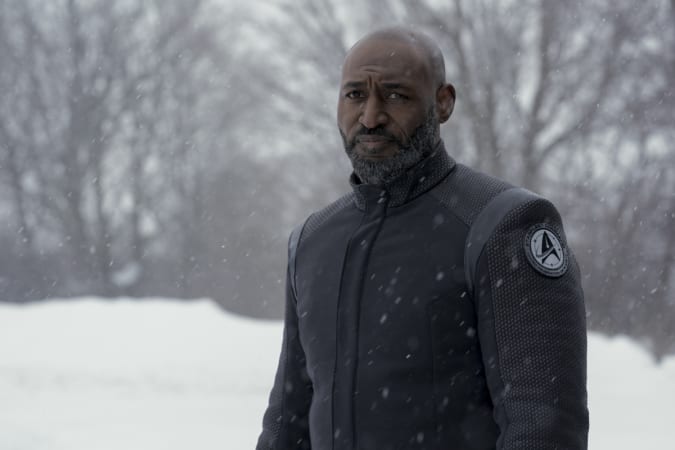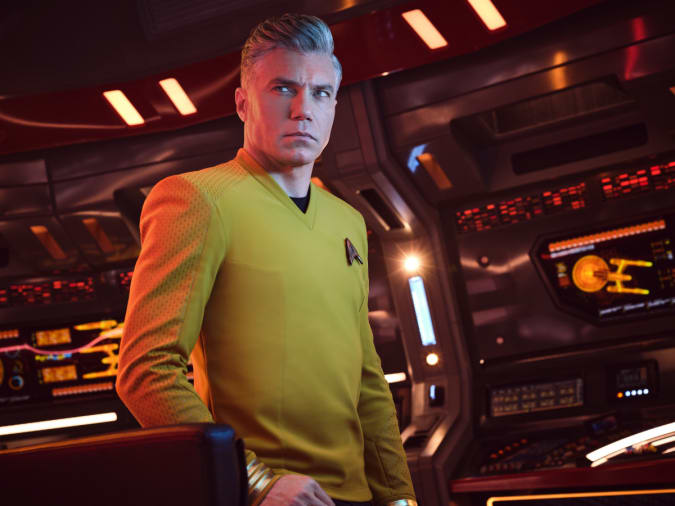The following contains spoilers for the premiere episode of ‘Star Trek: Strange New Worlds.’
Today Strange New Worlds makes its debut on Paramount+, the long-awaited third live action series in the new Kurtzman era. But, while Discovery carried the burden of being the first star trek show in 12 years and Picard saw the return of a beloved character after 17 years, Strange New Worlds is dealing with a more recent problem: It’s been billed by cast and crew alike as an answer to fan complaints about this new era of Trek, specifically as a return to more episodic storytelling. But, with its series premiere the show also felt the need to fire another shot across the bow to fans: a return to “message” Trek.
Star Trek, from the beginning, has always been imbued with Gene Roddenbury’s humanist philosophy. The original series was meant to depict a universe where all the nations and races of Earth had worked out their differences and traveled to the stars to meet other sentient species and overcome their differences with those groups. Many of the Enterprise’s adventures with alien species were often unsubtle allegories for real-world issues. For example (and most memorably), “Let That Be Your Last Battlefield,” whereby two warring members of the same species hate each other due to the color configuration of their faces — black on the right side, or black on the left side (they looked a lot like a black and white cookie, if you’ve ever eaten one of these New York classics).
Marni Grossman/Paramount+
The followup shows would tackle other issues in their own ways, from The Next Generation handling issues of drug addiction (badly), gender identity (also kind of badly) and basic civil rights (those were actually pretty good). Deep Space Nine can claim one of the best episodes of the entire franchise with “Far Beyond the Stars,” in which Captain Sisko experiences visions that place him in the shoes of a Black science fiction writer trying to tackle the racial injustices of the early 20th century.
That particular episode of Deep Space Nine is not just meaningful in what it has to say about race, but in the role of science fiction as a way to explore social issues and address injustices. There’s a quote from Stargate SG-1 (yeah, the other-other “Star” franchise) that I often go back to: “Science fiction is an existential metaphor that allows us to tell stories about the human condition.” That is, we can take real-world issues and bury them under fanciful elements such that we can portray them without immediately sending up someone’s hackles, then comment on them with the caveat, “This is just a ‘what if,’ after all; it’s not real.” It’s not real, but it makes you think. Science fiction is the storytelling equivalent of hiding your dog’s pills inside a treat.
Marni Grossman/Paramount+
However, Discovery and Picard have largely stayed away from “message” storytelling, choosing largely to focus on long-term character exploration over a long serialized story. If the shows chose to make any broad statements, it was by the mere presence of marginalized groups and integrating them into the universe: Discovery is the first show led by a Black female captain, with many of its main and recurring characters existing on the queer spectrum. Seven and Raffi are a couple on Picard, and Lower Decks even has an asexual character. But the shows for the most part, have shied away from overt messaging, even if wrapped in a science fiction coating.
Strange New Worlds upends that trend in its first episode, where Pike is sent to right a first contact mission gone wrong. For those unfamiliar with the trope, the Federation always reaches out to races developing warp engine technology for the first time, to catch them before they blunder out into trouble in outer space. It’s a fairly standard Star Trek plot, one that makes for a good standalone adventure to kick off a program that’s been billed as an “episodic” show. First contact episodes are good because both the characters and audience are meeting an alien species for the first time at the same time, so there’s no backstory to explain, nor are they expected to follow up (other ships have the task of continuing diplomatic relations, as seen in Lower Decks).
CBS
But in this case, the development of warp on the planet was not natural; instead the planet is not far from the events of Discovery at the end of season two and was witness to sights and readings that led them to build a warp device… as a bomb. While Starfleet protocol would dictate that the planet should just be allowed to blow themselves up, Pike decides to take responsibility instead, stepping in and delivering a message along the lines of The Day the Earth Stood Still, though less “we’ll blow you up” and more “don’t do this to yourselves.” There’s an entire speech about how Earth went through the same kind of struggles, and this is where the message stops being allegorical as Pike specifically shows footage of January 6th, 2021.
It’s rare for Star Trek to directly acknowledge the present day in its storytelling, partly because that facet of continuity is a mess (the worldwide Eugenics Wars were originally supposed to take place in the ’90s, for example) but mostly because it violates the whole “science fiction as metaphor” principle. When the show specifically points at something you personally know, something you’re almost sure to have an opinion on, it’s easy to feel like it’s turned against you when your opinions don’t align. Even if they do line up, people don’t particularly like being lectured. So for a show that’s trying to win back fans that seem to have turned away from this new era of Trek, it’s a weird path of Strange New Worlds to take.
CBS
But, between this and the season four finale of Discovery and its Stacey Abrams cameo, it seems that Star Trek has no interest in being metaphorical anymore; too many people are missing the point. There are those on the internet that love to complain about “woke” Trek even though the show has always addressed racism, sexism, gender identity, drug addiction, religious belief, terrorism, persecution of minorities, slavery, colonialism, environmentalism… the list goes on. Many of these situations weren’t even that subtle. And, despite insistences to the contrary, Starfleet is a military organization. The Federation is a government. Almost everything they do is political by definition. But that seems to have escaped many viewers, forcing the franchise to drag the real world in to make its point.
All products recommended by Engadget are selected by our editorial team, independent of our parent company. Some of our stories include affiliate links. If you buy something through one of these links, we may earn an affiliate commission.



